|
|
Carshalton 2007
Notes on the buses operated - part 4
Carshalton saw nine single deckers in service, plus one visiting
and one that didn't make it:
The bus that didn't make it was RF28, sadly
involved in a hit and run accident before its planned service on
the Gravesend 725 feeder service - which was cancelled as a
result. The bus hit the underside (yes, really) of
a stolen car that had rolled in front of it - the car can be seen
upside-down behind the bus. Luckily no-one was hurt, but the
car driver ran away, thus avoiding further injury. A picture
of RF28 in service on the 725 in happier times is here.
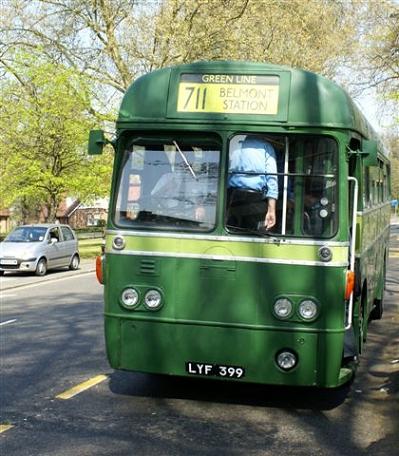
RF406 was delivered new to Sutton for the 213,
which it continued to work until its first overhaul in 1957.
It then spent a long spell at Merton for the 200, followed by
Bromley for the 227 and Leyton for the 236, where it was one of the
last doorless buses in service. Converted to one-man
operation (and fitted with doors) in 1970, it went to Uxbridge
where it stayed until withdrawal in 1976.
On 15 April 2007, RF406 was
back at Sutton on its first route, the 213.
Photo © Matthew Mabey
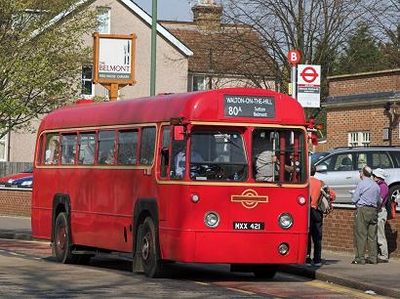
Our
RF486 was ably driven on the day by Claire Green,
with conductor Jemma Stevens. A history of the bus is
here.
Having loaded a Belmont
Station, RF486 heads up Downs Road for Carshalton Beeches and
Sutton Garage.
Photo © Mark
Lyons
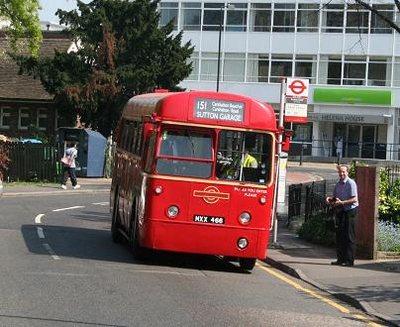
RF 491 was a Central
Area bus delivered in 1953. It began its career at Sidcup garage,
and during its first 15 years was allocated to West Green, Dalston,
Loughton, Norbiton, Edgware (replacing TD types) and New Cross
garages. In June 1966 it was converted to allow the driver to
collect fares, by the installation of power doors (previously the
entrance was open and the bus conductor operated). A luggage pen
was also installed in place of two seats. The vehicle
finished its passenger carrying LT career at Croydon garage on
route 234/A/B in 1972. It was then used as a training bus until
1977, when it was sold.
RF491 sets off from
Wallington on the special working of the 213 to New Malden.
Photo © Peter
Osborn
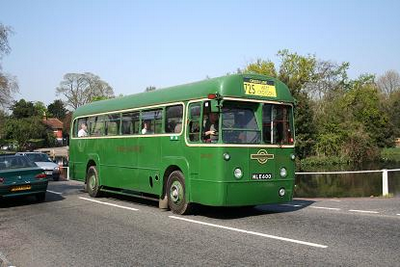
BL49 was never based
at Sutton, but similar buses operated the 80 and 80A,
taking over from RFs in 1976. BL49 entered service at
Kingston in 1976, followed by service in various parts of London,
finally at Highgate until 1990. A long spell as a training
bus followed (including at Westbourne Park garage, home of the 28
and 31 routes), until finally withdrawn in 1997.
BL49 sits in front of Sutton
garage as it heads for Belmont on the 80A.
Photo © Bob Lear
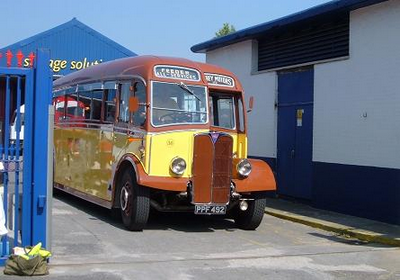
GS42 is actually
slightly newer than the RFs with registrations later in the MXX
sequence, having been delivered in November 1953,
entering service at Dorking. After little more
than a year, it disappeared north of the Thames, not to return to
Dorking until 1966 for another couple of years.
Ian Smith reports:
"the last scheduled ordinary GS public service was by London
Country on 29 March 1972, on the 336A from Garston
Garage, using regular GS42 plus spare GS33 (followed by an
unscheduled 309 journey back to Garston from
Rickmansworth)." (This brings to four the number of 'last
buses' present at Carshalton - the two RTs, the RTW and the
GS). GS42 was then sold and entered preservation a year
later.
GS42 was the surprise
visitor, certainly as far as the organisers were concerned!
The bus arrived in Epsom dressed as a 481 (a very local route for
the organisers) and proceeded to Sutton and Carshalton, where it is
seen here with DM1052 behind. You were very welcome.
Photo © Peter Larkham
|
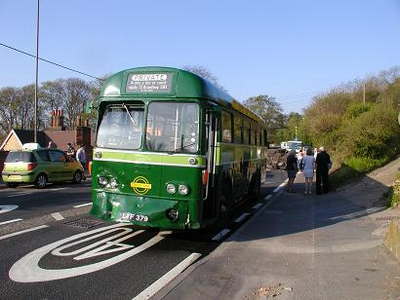
RF48 was delivered as a Green Line RF to
Reigate garage in November 1951 for use on route 711.
Moving in 1955, it worked from Crawley then moved north of the
river until 'modernisation' in 1966. Then based at Chelsham,
it was converted for OMO Green Line work in 1968 and transferred to
London Country in 1970. Moving from Chelsham to Northfleet in
1972, it was downgraded for bus work, ending its service at Dunton
Green in 1976.
RF48 on layover at the Mitcham Cricketers
stand.
Photo © Roger Ford
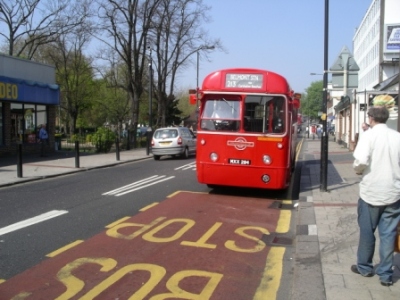
RF444 was one of the second batch of RFs
delivered to Dalston garage for the conversion of Q-operated
route 208 in early 1953, a few days after
the last LT Scooter had operated on the route. At Dalston
until 1961, the bus then moved to Sutton for the 213. After further moves around the system,
the bus was finally fitted with doors in 1972 and sent to Kingston,
where it remained until withdrawn in1977.
RF444 at Belmont California (now renamed The
Belmont) en route to Walton-on-the-Hill.
Photo © Richard Thomas
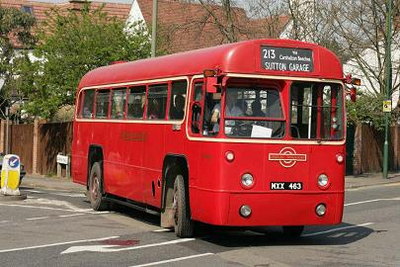
RF489 was one of the last batch of red RFs
delivered, going to Sidcup for busy route 241 in 1953. Spells followed at
Muswell Hill (210, 212), Dalston (208,
208A), Kingston and finally Tottenham
(236) before conversion to one-man
operation and the fitting of doors in 1966. It then went to
Enfield for the OMO conversion of the 121. After its final
overhaul in 1973, it went to Norbiton and Kingston until late 1977,
when it was withdrawn.
RF489 operated part of the
original timetable for the short-lived 151 RF route, seen here
setting down in Bushey Road.
Photo © Peter Larkham
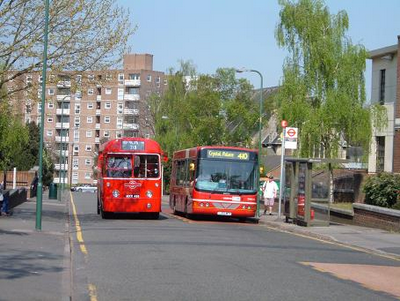
RF600 was a Country
Area RF throughout its service life (although briefly painted red
in preservation), working from Guildford from new in 1953 for four
years, then travelling to the northern area for work from Garston,
Hertford and St Albans. The bus was converted for one man
operation in 1958, well before the Central Area conversions, and
lasted just into the London Country era, being withfdrawn from
Hertford in 1971.
RF600 speeds past Carshalton
Ponds on the first orbital Green Line route 725.
Photo © Paul Bowery
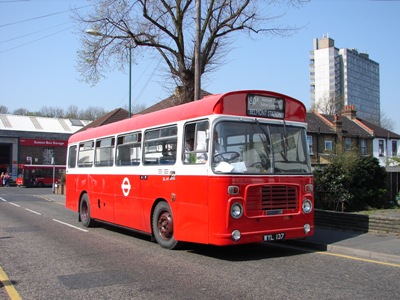
Surrey Motors coach PPF492.
An AEC Regal III with a very late production half-cab
Harrington 37-seat body, built in 1951 to the then newly allowable
width of 8 feet. Delivered new to Surrrey Motors of Sutton,
whose garage was situated between LT's Sutton and Carshalton
garages, it was numbered 36 in their fleet and used for holiday
tours. It worked for them until 1963 and has been beautifully
preserved for many years by David Hurley.
Seen emerging from Carshalton Depot on 15 April
2007, No.36 operated tours of its original pick-up
points.
Photo © Peter Osborn
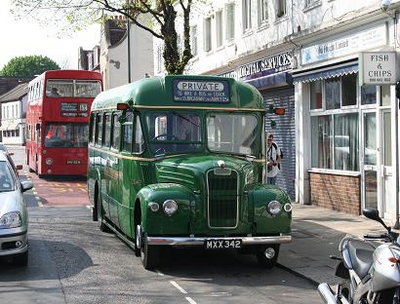
|